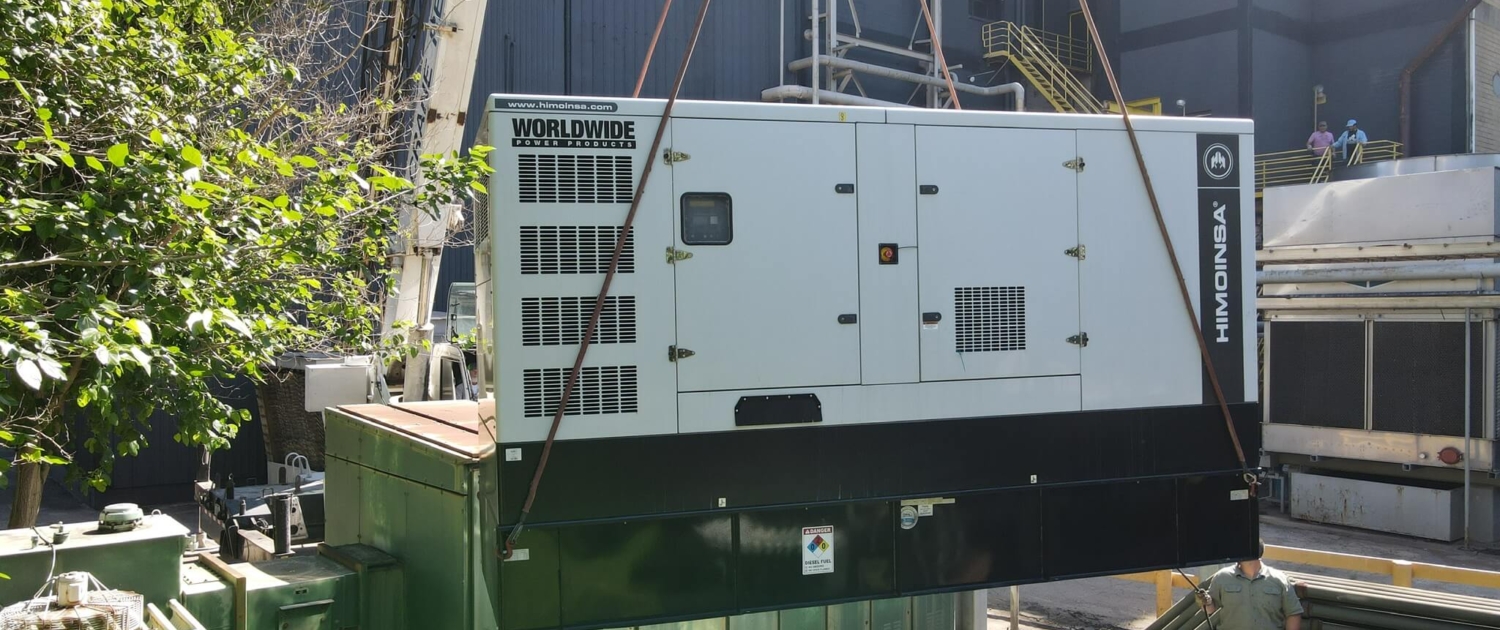Site Planning for Industrial Generator Installation
Industrial generators are typically massive pieces of equipment, and rightly so–they may be called upon to power your entire business’ operations when grid power fails.
Because of their complexity, their unavoidable propensity to emit fumes and noise, their sheer size, and the significant financial investment they require, owners must dedicate careful thought to planning the site their generator installations will go.
This will ensure you avoid fines from regulatory agencies and get years of reliable service from your generator.
We’re taking a look at how to prep the perfect site for a commercial generator.
Before beginning, you’ll need to know what size generator you need. If you need help determining this info, check out our Generator Sizing Guide and explore the Diesel Fuel Consumption Chart to understand your fuel storage needs before continuing.
Will Your Generator Be Inside or Outside?
You can quickly narrow down your generator site search by determining whether you’ll place the generator set inside or outside.
Outdoors is the more popular option for commercial applications for fairly simple reasons: outside is easier and cheaper.
Installing the generator inside requires a dedicated generator room far from customers or unauthorized employee access due to the noise and fumes they give off.
The building and fire codes are also stricter for indoor applications, necessitating the services of design planners and mechanical engineers in addition to a master electrician, hence the higher costs.
However, if you have the floor space (including clearance and room to work) and can fuel it and operate it safely, an indoor generator offers the benefits of a controlled climate, easier access (with weather not a factor), and enhanced safety and security.
Fuel Type: Natural Gas vs. Diesel
Some people in the market for a commercial generator let their facility’s utility hookups and site layout determine what type of unit they should buy, but you can also do this thought experiment in reverse: a/k/a decide where your generator should go based on the fuel type of the unit you’ve decided on.
For example, you may prefer a diesel unit because of its strength and reliability, including not having to worry about your natural gas line being shut off in an emergency. Diesel exhaust emissions and on-site storage tanks mean more space that’s required, which can be a problem if you’re trying to house the tanks and the genset inside in the same room.
Fuel supply lines can be run to interior locations, if necessary, but that carries a cost and pushes your installation date farther out. But if you already have a natural gas hookup indoors that’s accessible, it could be worth it to you to go with a natural gas generator and site it indoors, where it would be quieter and lower emitting than a diesel unit.
Or, you could stick with diesel if you have the space in a room that’s sufficiently far from people hearing the noise and sufficiently ventilated to prevent anyone from being impacted by the fumes.
In short, fuel type is a major aspect that you’ll need to take into your site planning calculations, and what works for each commercial generator owner can vary quite a bit.
Outdoor Installation Options: Permanent or Portable
If you decide to deploy your commercial generator outside, there are two installation types or generator types that you can take advantage of, depending on your needs, but either way the generator will have to be protected from the elements somehow:
A permanent enclosed generator fixes the generator in one location on a concrete pad inside a housing that may be specially designed to attenuate sound or extreme hot or cold beyond what an average enclosure can do.
A portable enclosed generator is a trailer-mounted or van-carried unit that you can likely move throughout your premises as your operations require. It will also be housed in an enclosure that you can access for maintenance.
Let’s look at the site planning details for each type.
Site Planning for Permanent Generators
- Access: Will you be able to …
- Reach the unit to perform maintenance? There should be adequate space between the unit and the backup fuel supply tank and your building.
- Drive the fuel truck close enough to connect to the unit for refueling?
- Connect to the facility’s switch panel?
- Security: How will you protect the unit from theft/vandalism/tampering/etc.?
- Fencing?
- Security cameras?
- Adequate lighting?
- Fuel-level sensors?
- Security guards?
- Concrete pads: Have you made sure…
- You’ve achieved the appropriate thickness of the pads based on soil composition and the weight of the units (generator and tank)?
- You’ve followed local, state, and federal guidelines?
- You’ve followed manufacturer guidelines?
- You’ve allowed for enough space for the generator and tank with at least 6” (preferably 12”) of extra space on the sides of the pad?
- You have a spill containment solution (a berm or basin)?
Site Planning for Portable Generators
Portable industrial generators offer the simplest site planning.
You’ll need an access road with sufficient side and head clearance for moving it in and out and fueling it.
Many owners elect to operate their generators directly from the trailer or truck bed, but if you opt to move yours off the trailer, you’ll need capable lifting gear and a landing spot that can hold the weight.
Consult the manufacturer guidelines to be sure you have both, as well as the best way to position the generator.
Planning an Indoor Generator Installation Site
If you have a generator that’s tasked with supporting a specific sector of your operations as either primary or backup power, you may choose to install it indoors.
As always, consult local, state, and federal regulations before preparing the site.
To ensure optimal performance and safety, your dedicated generator room will require:
- headroom and sideroom clearance for placing the generator
- a concrete pad and skid mount positioned to provide access room and to meet building codes (NFPA and NEC)
- a ventilation air source, preferably low to the ground at the rear of the unit and with louvers if needed to assist in cooling
- a ductwork exhaust system with minimal bends and preferably wrapped with heat-insulating material such as aluminum silicate
- a fuel supply line, piped under the floor and protected by grating, if required
- either an adjacent, air-conditioned room for controls and switchgear or switchgear located near the incoming air source
- electrical drops
- a sound insulation system for the room such as glass wool panels and fireproof/soundproof door, if the generator doesn’t have a sound-attenuating enclosure
- a metal cabinet in which to store the genset’s instruction manuals, special tools, and spare parts
When you’re ready to install, you’ll need either a truck or crane to offload the permanent generator and place it on the pad with skid mount.












